Congenital and prolonged adult-onset deafness cause distinct degradations in neural ITD coding with bilateral cochlear implants
- PMID: 23462803
- PMCID: PMC3642270
- DOI: 10.1007/s10162-013-0380-5
Congenital and prolonged adult-onset deafness cause distinct degradations in neural ITD coding with bilateral cochlear implants
Abstract
Bilateral cochlear implant (CI) users perform poorly on tasks involving interaural time differences (ITD), which are critical for sound localization and speech reception in noise by normal-hearing listeners. ITD perception with bilateral CI is influenced by age at onset of deafness and duration of deafness. We previously showed that ITD coding in the auditory midbrain is degraded in congenitally deaf white cats (DWC) compared to acutely deafened cats (ADC) with normal auditory development (Hancock et al., J. Neurosci, 30:14068). To determine the relative importance of early onset of deafness and prolonged duration of deafness for abnormal ITD coding in DWC, we recorded from single units in the inferior colliculus of cats deafened as adults 6 months prior to experimentation (long-term deafened cats, LTDC) and compared neural ITD coding between the three deafness models. The incidence of ITD-sensitive neurons was similar in both groups with normal auditory development (LTDC and ADC), but significantly diminished in DWC. In contrast, both groups that experienced prolonged deafness (LTDC and DWC) had broad distributions of best ITDs around the midline, unlike the more focused distributions biased toward contralateral-leading ITDs present in both ADC and normal-hearing animals. The lack of contralateral bias in LTDC and DWC results in reduced sensitivity to changes in ITD within the natural range. The finding that early onset of deafness more severely degrades neural ITD coding than prolonged duration of deafness argues for the importance of fitting deaf children with sound processors that provide reliable ITD cues at an early age.
Figures
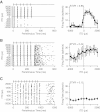
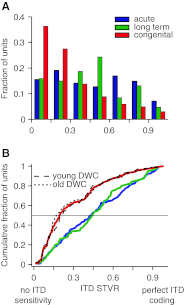
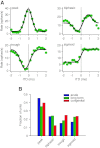

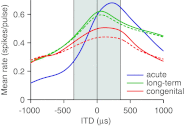

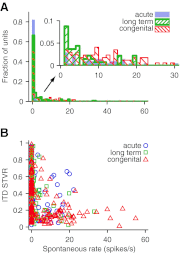
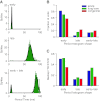
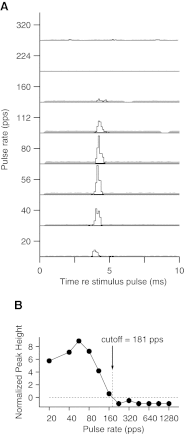
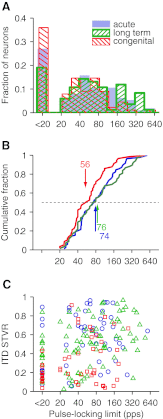
Similar articles
-
Neural ITD Sensitivity and Temporal Coding with Cochlear Implants in an Animal Model of Early-Onset Deafness.J Assoc Res Otolaryngol. 2019 Feb;20(1):37-56. doi: 10.1007/s10162-018-00708-w. Epub 2019 Jan 8. J Assoc Res Otolaryngol. 2019. PMID: 30623319 Free PMC article.
-
Neural Processing of Acoustic and Electric Interaural Time Differences in Normal-Hearing Gerbils.J Neurosci. 2018 Aug 1;38(31):6949-6966. doi: 10.1523/JNEUROSCI.3328-17.2018. Epub 2018 Jun 29. J Neurosci. 2018. PMID: 29959238 Free PMC article.
-
Neural coding of interaural time differences with bilateral cochlear implants: effects of congenital deafness.J Neurosci. 2010 Oct 20;30(42):14068-79. doi: 10.1523/JNEUROSCI.3213-10.2010. J Neurosci. 2010. PMID: 20962228 Free PMC article.
-
Bilateral cochlear implants in children: Effects of auditory experience and deprivation on auditory perception.Hear Res. 2016 Aug;338:76-87. doi: 10.1016/j.heares.2016.01.003. Epub 2016 Jan 30. Hear Res. 2016. PMID: 26828740 Free PMC article. Review.
-
Perception and coding of interaural time differences with bilateral cochlear implants.Hear Res. 2015 Apr;322:138-50. doi: 10.1016/j.heares.2014.10.004. Epub 2014 Oct 19. Hear Res. 2015. PMID: 25456088 Review.
Cited by
-
Specific loss of neural sensitivity to interaural time difference of unmodulated noise stimuli following noise-induced hearing loss.J Neurophysiol. 2020 Oct 1;124(4):1165-1182. doi: 10.1152/jn.00349.2020. Epub 2020 Aug 26. J Neurophysiol. 2020. PMID: 32845200 Free PMC article.
-
Evaluating the Impact of Age, Acoustic Exposure, and Electrical Stimulation on Binaural Sensitivity in Adult Bilateral Cochlear Implant Patients.Brain Sci. 2020 Jun 26;10(6):406. doi: 10.3390/brainsci10060406. Brain Sci. 2020. PMID: 32604860 Free PMC article.
-
Neural ITD Sensitivity and Temporal Coding with Cochlear Implants in an Animal Model of Early-Onset Deafness.J Assoc Res Otolaryngol. 2019 Feb;20(1):37-56. doi: 10.1007/s10162-018-00708-w. Epub 2019 Jan 8. J Assoc Res Otolaryngol. 2019. PMID: 30623319 Free PMC article.
-
Neural Processing of Acoustic and Electric Interaural Time Differences in Normal-Hearing Gerbils.J Neurosci. 2018 Aug 1;38(31):6949-6966. doi: 10.1523/JNEUROSCI.3328-17.2018. Epub 2018 Jun 29. J Neurosci. 2018. PMID: 29959238 Free PMC article.
-
Ear-Specific Hemispheric Asymmetry in Unilateral Deafness Revealed by Auditory Cortical Activity.Front Neurosci. 2021 Jul 30;15:698718. doi: 10.3389/fnins.2021.698718. eCollection 2021. Front Neurosci. 2021. PMID: 34393711 Free PMC article.
References
-
- Batra R, Kuwada S, Fitzpatrick DC. Sensitivity to interaural temporal disparities of low- and high-frequency neurons in the superior olivary complex. II. Coincidence detection. J Neurophysiol. 1997;78:1237–1247. - PubMed
Publication types
MeSH terms
Grants and funding
LinkOut - more resources
Full Text Sources
Other Literature Sources
Medical
Miscellaneous

